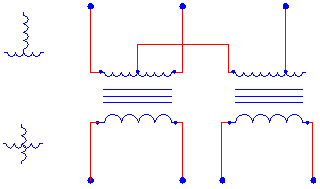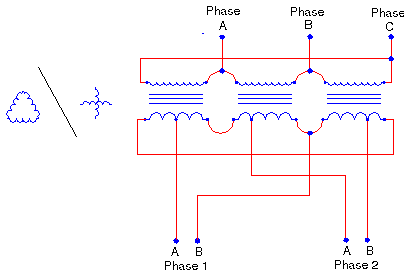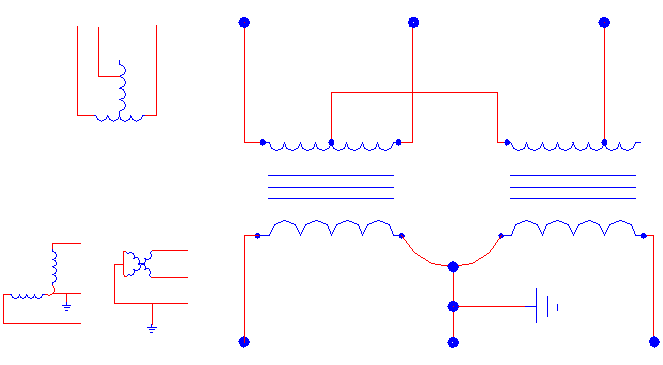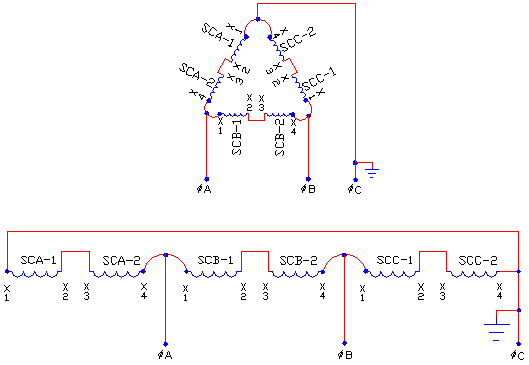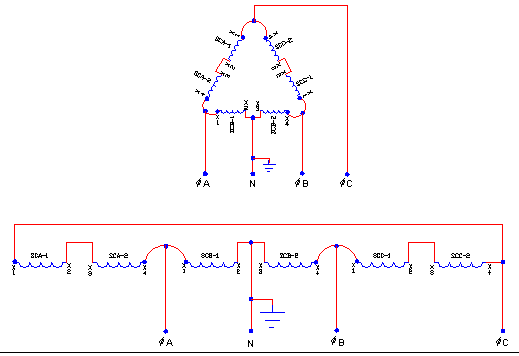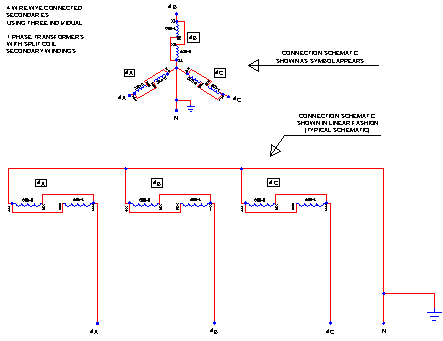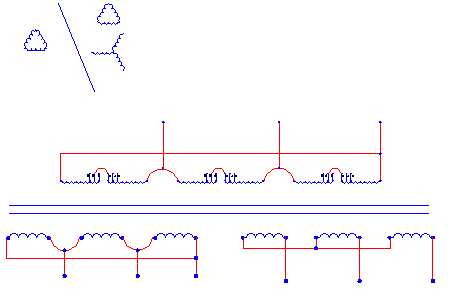Re: 2 phase panel
Here's what the differences are, between a 2? and a 3?, 6?, or 9? Systems' Transformer connection scheme:
-----------------------------------
PART 1: 2? (2 Phase) Systems
-----------------------------------
Fig. 1a: 2? Transformer Connection Scheme #1;
2? 3 Wire "Tee" Primary x 2? 4 Wire Secondary.
----------------------------------------------
----------------------------------------------
Fig. 1b: 2? Transformer Connection Scheme #2;
3? 3 Wire Delta Primary x 2? 4 Wire (Taylor) Secondary.
------------------------------------------------
------------------------------------------------
Fig. 1c: 2? Transformer Connection Scheme #3;
2? 3 Wire "Tee" Primary x 2? 3 Wire "Vee" Secondary.
------------------------------------------------
------------------------------------------------
Link for details to the 2 Phase Schematics:
2 Phase Transformer Schematics
-----------------------------------------------
-----------------------------------------------
-----------------------------------------
PART 2: 3? (3 Phase) Delta Systems
-----------------------------------------
Fig. 2a: 3? Delta Transformer Connection Scheme #1;
3? 3 Wire Delta Secondary.
------------------------------------------------
------------------------------------------------
Fig. 2b: 3? Delta Transformer Connection Scheme #2;
3? 4 Wire Delta Secondary.
------------------------------------------------
------------------------------------------------
Fig. 2c: 3? Delta Transformer Connection Scheme #3;
3? 4 Wire Open Delta "Vee" Secondary
------------------------------------------------
------------------------------------------------
Link for details to the 3 Phase Delta Schematics:
3 Phase Delta Transformer Schematics
------------------------------------------------
------------------------------------------------
-----------------------------------------
PART 3: 3? (3 Phase) Wye Systems
-----------------------------------------
Fig. 3a: 3? Wye Transformer Connection Scheme;
3? 4 Wire Wye Secondary.
------------------------------------------------
------------------------------------------------
Link for details to the 3 Phase Wye Schematics:
3 Phase Wye Transformer Schematic
------------------------------------------------
------------------------------------------------
-----------------------------------------
PART 4: 6? & 9? Systems
-----------------------------------------
Fig. 4a: 6? Transformer Connection Scheme;
3? 3 Wire Delta Primary x 6? (3 Wire Delta + 3 Wire Wye) Secondary
------------------------------------------------
------------------------------------------------
Fig. 4b: 9? Transformer Connection Scheme;
3? 3 Wire Delta Primary x 9? (3 Wire Delta + 3 Wire Wye + 3 Wire Wye) Secondary
***NOTE***
"Fig. 4b 9? Transformer Schematic exceeded maximum images per post (max is 8 images). To view this drawing, please use the link below.
------------------------------------------------
------------------------------------------------
Link for details to the 6 & 9 Phase Schematics:
6 and 9 Phase Transformer Schematics
Scott35
edited duew teu sphelleeng airrors (edited, due to spelling errors) ... D'OHH
[ June 13, 2005, 09:24 PM: Message edited by: scott thompson ]

